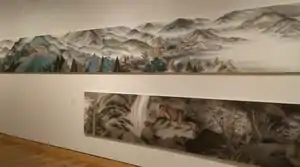Minol Araki
Minol Araki or Minoru Araki (荒木 實, 1928 – 2010) was a Japanese painter and industrial designer.[1]
Minol Araki | |
|---|---|
荒木 實 | |
| Born | 1928 |
| Died | 2010 (aged 81–82) |
| Nationality | Japanese |
| Known for | painting and industrial design |
| Style | Japanese Zen, contemporary abstract, Nihonga |
Life and education
Araki was born in Dalian, in Japanese-occupied Kwantung Leased Territory, in 1928.[2] His father owned a restaurant and died when Araki was a teenager.[3] Araki began painting at an early age and at age seven entered the tutelage of an old Chinese painter who his parents were friends with.[2] He studied traditional Chinese painting until moving back to Japan after World War II. He then pursued graphic design and industrial design, and studied under modernist and avant-garde artists in Tokyo.[4] Araki died in 2010.[1]
Work

Inspired in part by Raymond Loewy's book Never Leave Well Enough Alone, Araki started a career in industrial design in the 1950s.[2] In the 1960s, he started a network of design studios.[4] During his career as a designer, Araki worked on housewares such as lamps, calendars, and organizers, and byōbu, traditional Japanese folding screens.[2][4]
In the 1970s, Araki was mentored by painter Zhang Daqian. After Zhang's death, Araki created five paintings demonstrating his mentor's influence and his personal interest in modern Japanese painting methods. These paintings, which are each over 70 feet long, contain multiple panels illustrating landscapes, dragons, and other natural scenes.[4] In addition to influences from Zhang, these paintings also demonstrate influence from Bada Shanren, Ben Shahn, and medieval Japanese Zen painters.[5]
Araki's work was also influenced by his travels, and by painters Henri de Toulouse-Lautrec and Egon Schiele. Another interest was Pablo Picasso and other contemporary abstract painters. Through various styles, Araki is known for his literati painting and expressing his unique perspective as someone with various cultural influences, both from upbringing and his travels.[6] Araki's best-known piece is Snow Monkeys at Play in Autumn and Winter, a work that is inspired by the Nihonga painting style of 20th-century Japan.[2] He is also known for a series of lotus paintings.[2]
Unlike most artists, Araki did not collect old paintings, preferring to save antique painting instruments, like brushes, ink and inkstones, and paper. This may have been inspired by his mentor Zhang's work in textile dyeing.[2][7] For most of his career, Araki did not exhibit or sell any of his pieces. His business work allowed him the financial freedom to pursue his art without having the need to sell it.[3]
On his art, Araki said, "My painting is a celebration of nature, a grateful song to all forms of creation expressed through brush painting. By drawing from both East and West, I hope to achieve a perspective which is international, a bridge between cultures."[2]
Collections
Araki's work has been exhibited in the collections and/or traveling exhibits of the following:[4]
- Erik Thomsen Gallery in New York[7]
- Metropolitan Museum of Art[8]
- Minneapolis Institute of Art[9]
- National Museum of History in Taipei
- Phoenix Art Museum (1999)[10]
References
- Aaron Rio (2017). Boundless Peaks: Ink Painting by Minol Araki. Matthew Rezac (designer). Minneapolis Institute of Art. ISBN 978-0-99626-999-5.
- Claudia Brown (1999). Minol Araki: Nature in Ink. Phoenix Art Museum. pp. 12–15. ISBN 0-91-040736-3.
- Gomez, Edward M. (June 22, 1999). "A Late Bloomer's Leap from Design to Fine Art". The New York Times.
- "Minneapolis Institute of Art opens first complete retrospective of Japanese painter Minol Araki". ArtDaily. Minneapolis, MN. Retrieved February 17, 2018.
- "Exhibition: Boundless Peaks: Ink Paintings by Minol Araki — Minneapolis Institute of Art". Minneapolis Institute of Art. 2017–2018. Retrieved February 17, 2018.
- Kuzui, Fran (October 3, 2017). "Minol Araki, painter without a home". Nikkei Asian Review. Retrieved February 18, 2018.
- Erik Thomsen (2015). "Minol Araki: Nature in Ink" (PDF). Erik Thomsen Gallery. Retrieved February 17, 2018.
- "Minol Araki (Araki Minoru 荒木實) | Distant Road 永遠的路 | Japan | Shōwa period (1926–89)". The Met. Retrieved February 17, 2018.
- "Exhibitions – January 2018". Society for Japanese Arts. 2018. Retrieved February 17, 2018.
- "East Asian Art and Archaeology Newsletter". UM Libraries. 1998. p. 11.